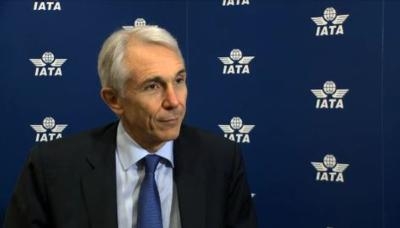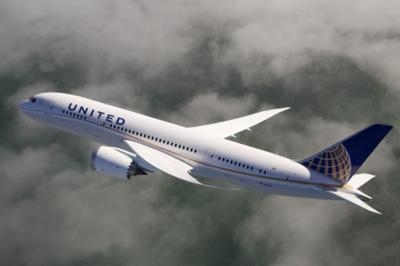Projects 5.1% Net Profit Margin For 2016
The International Air Transport Association (IATA) has unveiled its airline industry outlook for 2016 which sees an average net profit margin of 5.1% being generated with total net profits of $36.3 billion. IATA also announced a revision to its airline industry outlook for 2015 upwards to a net profit of $33 billion (4.6% net profit margin) from $29.3 billion forecast in June.

“This is a good news story. The airline industry is delivering solid financial and operational performance. Passengers are benefiting from greater value than ever—with competitive airfares and product investments. Environmental performance is improving. More people and businesses are being connected to more places than ever. Employment levels are rising. And finally our shareholders are beginning to enjoy normal returns on their investments,” said Tony Tyler, IATA’s Director General and CEO (pictured).
The strengthening industry performance is being driven by a combination of factors:
- Lower oil prices (forecast to be $55/barrel Brent in 2015 and averaging a lower $51/barrel in 2016) are giving airline profits a boost; however this is strongly moderated in many markets by the appreciation of the US dollar
- Strong demand for passenger travel (+6.7% growth in 2015 and +6.9% in 2016) is making up for disappointing cargo demand growth (+1.9% in 2015; strengthening to 3.0% in 2016). Weak cargo performance reflects sluggish growth in trade
- Stronger economic performance in some key economies (including a faster than expected recovery in the Eurozone) is outweighing the overall impact of slower growth in China and the downturn in the Brazilian economy. Global GDP growth is expected to improve to 2.7% in 2016 (up from 2.5% for 2015)
- Efficiency gains by airlines are illustrated by record high load factors (80.6% in 2015, tapering slightly to 80.4% in 2016). Capacity is increasing and is expected to move ahead of demand growth in 2016. Yields, however, continue to deteriorate amid stiff competition
In 2016 total passenger numbers are expected to rise to 3.8 billion traveling over some 54,000 routes.
In both 2015 and 2016 the industry’s return on capital (8.3% and 8.6% respectively) is expected to exceed the industry’s cost of capital (estimated to be just under 7.0% in 2015 and 2016 because of low bond yields).
“This is an historic achievement for an industry that has been notorious for destroying capital throughout its history. But let’s keep that achievement in perspective. With net profit margins still in the 5% range there is little buffer. Achieving returns that barely exceed the cost of capital means that airlines are finally meeting the minimum expectations of their shareholders. For most other industries this is the norm and not the exception.
And this is coming as expectations build that we are nearing the top of the business cycle. On average airlines will still make less than $10 per passenger carried. The industry’s profitability is better described as ‘fragile’ than ‘sustainable’,” said Tyler.
There are several indicators that improvements in airline profitability are likely to slow. The first is found in the cyclical nature of the airline business. Historically the airline industry profitability cycle is 8-9 years from peak to peak (or trough to trough). The low point of this cycle was 2009. The second is the anticipation of the economic impact of interest rates rising from current exceptionally low levels. And lastly, airlines will soon have realized the maximum positive impact of lower fuel prices with most of the higher-than-market hedges due to unwind in 2016.
IATA projects that 2016 will continue the main trends from 2015. Major drivers of performance in 2016 include:
- Revenues: Revenues are expected to rise by 0.9% to $717 billion in 2016. Industry revenues peaked in 2014 at $758 billion, then declined to $710 billion in 2015 with the impact of the strengthening of the US dollar on non-dollar revenues. The increase in revenues in 2016 is expected to be wholly due to the contribution of the passenger side of the business ($525 billion in 2015 rising to $533 billion in 2016). Cargo revenues are expected to decline slightly to $50.8 billion (from $52.2 billion in 2015).
- Demand: The demand for passenger travel is expected to grow by 6.9% (similar to the 6.7% growth expected in 2015) with 3.8 billion passengers expected to travel in 2016. Passenger capacity is expected to grow slightly ahead of demand at 7.1% which is an acceleration from the 5.5% capacity expansion in 2015. Demand for air cargo is expected to accelerate in 2016 to 3.0%, ahead of the 1.9% growth in 2015. This is slightly ahead of GDP growth which is expected to average 2.7% in 2016. Prior to the Global Financial Crisis this pace of economic growth would have generated much faster international trade and air cargo growth, but that pattern of growth appears to have stopped as companies bring supply chains closer to home. In total, the industry is expected to uplift 52.7 million tonnes of cargo in 2016.
- Yields: The cost of travel and shipping is expected to continue to decline with average yields for passengers falling 5% and cargo falling by 5.5% in 2016. The pace of decline is a deceleration from 2015 when cargo yields are expected to fall by 18.0% and passenger yields by 11.7%. About 6.0 percentage points of the 2015 decline can be attributed to the appreciation of the US dollar and the impact this has when accounting for non-US dollar revenues.

North American carriers are leading the industry’s performance and are expected to generate considerably more than half the industry’s total profits in both 2015 ($19.4 billion) and 2016 ($19.2 billion). On a per passenger basis, profits of $21.44 in 2016 also places their performance at the top of the industry.
European airlines are expected to deliver performance improvements with net profits increasing from $6.9 billion in 2015 to $8.5 billion in 2016. Lower fuel costs (hedging rates of 80-90% for the majority of large airlines has delayed much of the benefit from low fuel prices into 2016), a faster than expected recovery of the European economy and strong performance on business travel on North Atlantic routes is benefitting the region.
Profits for the Asia-Pacific region are expected to grow from $5.8 billion in 2015 to $6.6 billion in 2016. Overall profits per passenger for 2016 are forecast at $5.13, well behind both the US and Europe. Although the Chinese economy has slowed, air travel remains strong.
Middle East carriers are expected to see collective profits of $1.4 billion in 2015 which is lower than the previously forecast $1.8 billion. The region is expected to recover most of the lost ground with a $1.7 billion net profit in 2016. The Middle East is, however, split between strong Gulf airlines, with successful long-haul super-connector operations, and regionally-focused airlines which are suffering from the impact of lower oil revenues and political conflict.
The performance of carriers in Latin America is weak on the back of the deepening economic crisis in Brazil, weak commodity prices and adverse currency fluctuations. The region is expected to finish 2015 with a $300 million loss, recovering to a $400 million profit in 2016. Recent elections in Venezuela and Argentina are expected to result in a more business-friendly environment for airlines.
Airlines in Africa are expected to be in the red in both 2015 and 2016 with losses of $300 million and $100 million, respectively. The region’s losses per passenger make its performance in 2015 worse than Latin America’s. Political instability is impacting important tourism markets in North Africa. The continent’s carriers in general suffer from weak economies and stiff competition on international markets. Growth is also weak, with a 0.4% capacity expansion expected for 2015 increasing to 1.6% in 2016.
(Source: IATA news release. Images from file)
 ANN's Daily Aero-Term (04.24.24): Runway Lead-in Light System
ANN's Daily Aero-Term (04.24.24): Runway Lead-in Light System ANN's Daily Aero-Linx (04.24.24)
ANN's Daily Aero-Linx (04.24.24) Aero-FAQ: Dave Juwel's Aviation Marketing Stories -- ITBOA BNITBOB
Aero-FAQ: Dave Juwel's Aviation Marketing Stories -- ITBOA BNITBOB Classic Aero-TV: Best Seat in The House -- 'Inside' The AeroShell Aerobatic Team
Classic Aero-TV: Best Seat in The House -- 'Inside' The AeroShell Aerobatic Team Airborne Affordable Flyers 04.18.24: CarbonCub UL, Fisher, Affordable Flyer Expo
Airborne Affordable Flyers 04.18.24: CarbonCub UL, Fisher, Affordable Flyer Expo




